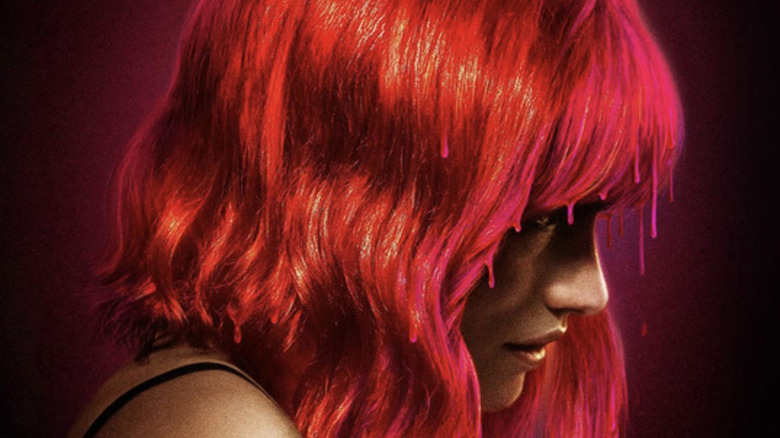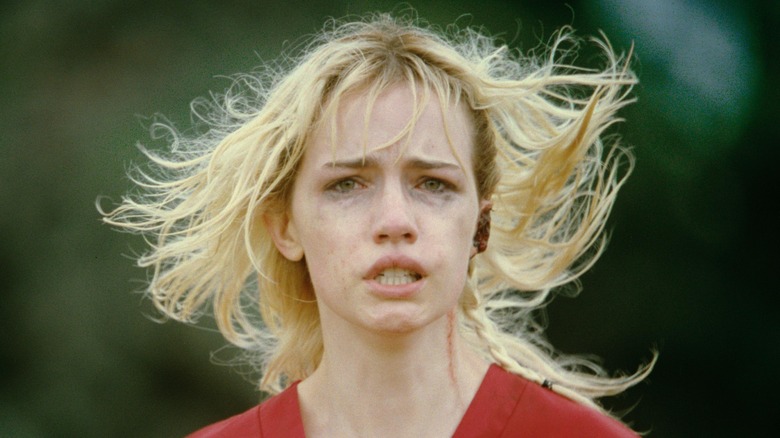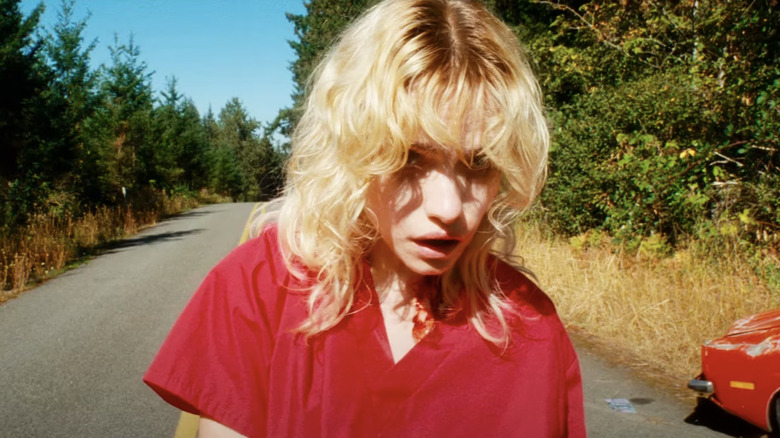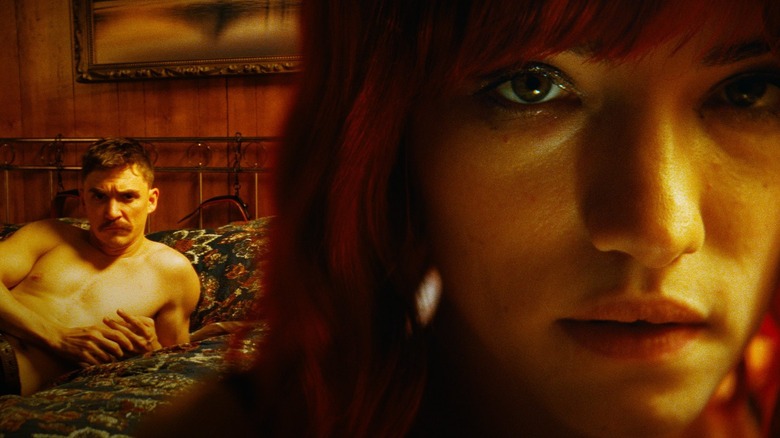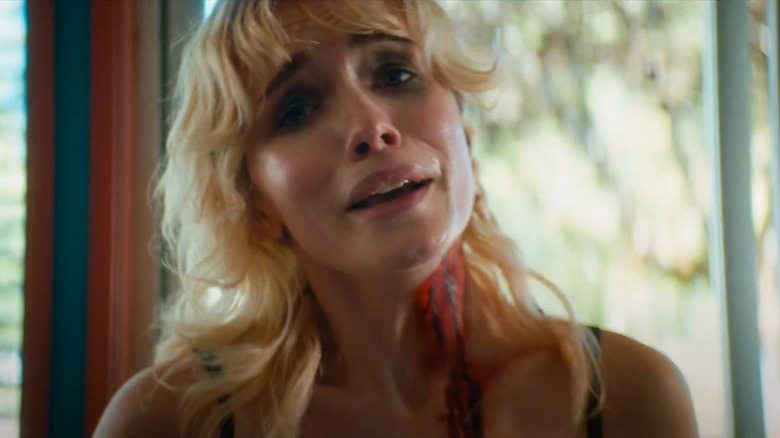Strange Darling Flips One Of Horror Movies' Oldest Tropes
Major spoilers for "Strange Darling" follow.
Director J.T. Mollner's indie horror flick "Strange Darling" has finally opened in U.S. theaters with the wind of good publicity at its back. In a fascinating career pivot, "Strange Darling" was shot on 35mm film by actor Giovanni Ribisi making his debut as a cinematographer. Then, there's the promise of a twist in both the film's marketing and reviews. (Read /Film's positive review of "Strange Darling" here, which promises a film that will "keep you guessing.")
"Go in blind" is easy criticism when a film anchors itself with a twist but "Strange Darling" earns that rave. The film is introduced as a story told in six chapters, but those chapters are presented out of order. (The non-chronological structure unfolds like this: 3, 5, 1, 4, 2, 6, epilogue.) Mollner banks on his audience's genre and gendered expectations as he assembles the movie's puzzle pieces together before their eyes.
So, what does "Strange Darling" appear to be about? A young woman, "The Lady," (Willa Fitzgerald) is fleeing a man, "The Demon" (Kyle Gallner). Every fiber of the Lady's being is shaking with terror while the Demon wields a hunting rifle. Is he a serial killer hunting the most dangerous game? No, but the movie wants you to think that he is. It turns out the Lady is the killer, having lured "The Demon" into a one night stand before attempting to murder him. After she carved her initials into his skin ("EL" for "Electric Lady"), he escaped and is now pursuing her in revenge.
Carol J. Clover coined the term "Final Girl" for how many horror movies star scrappy, scared but resourceful, and above all resilient young women dodging killers. "Alien," "Halloween," "Scream" — we know what the heroes of movies like "Strange Darling" look like and it's a lot like Willa Fitzgerald. In "Strange Darling," this final girl is only so because she kills everyone else in her path.
How Strange Darling fakes out its audience
"Strange Darling" opens with a faux true story disclaimer ripped out of "The Texas Chain Saw Massacre," claiming the movie dramatizes the final murders of a killer in the American northwest. The movie then seemingly gives us the answer of who this killer is by cutting to a profile shot of The Demon. The offscreen Lady asks if he's a serial killer; cue a smash cut to a close-up of his face as he chokes her.
Then the movie cuts to a wide, slow-motion shot of the Lady running through a field towards the screen; we gradually absorb her terrified expression in greater detail. She's bleeding from her ear and clearly in fear for her life.
This all seems open and shut, doesn't it? The Demon is a hunter and the Lady is a survivor who escaped. Mollner thought so. In an interview with Screen Rant, he revealed that the first shot of the Lady was the seed from which "Strange Darling" grew. He saw a woman in red hospital scrubs running through a forest in slow motion as Nazareth's song "Love Hurts" played — despite the detail, "It seemed very archetypal," Mollner said. That inspired him to think about how he could reinvent the idea of a final girl, and in "Strange Darling," he takes his audience on that same journey.
The opening scenes give us no reason to doubt that the Demon is a bad guy and that the Lady is a victim. But why are we starting with chapter 3, you'll ask yourself, and that sets you up to expect some kind of left turn. Chapter 3 of "Strange Darling" is designed to play to your expectations so much that you aren't expecting what the twist ends up being, though. It's a tightrope balancing act where the film surprises you but doesn't rip you off.
Strange Darling sets up Willa Fitzgerald to be Laurie Strode, not Michael Myers
When the film begins in earnest, the Lady is driving a car down a rural road and the Demon is pursuing her in a truck. "The Texas Chain Saw Massacre" ends with blood-soaked final girl Sally (Marilyn Burns) being carried away in the back of a pickup truck, laughing in horrified euphoria that her nightmare is over.
The opening of "Strange Darling" feels like it follows on from that; we presume that the Lady has gone through similar trauma and her shaken appearance is because her mind is frozen with shock but adrenaline is pumping her body. Gallner, dressed in a lumberjack's red flannel with a gun-nut mustache, is sniffing cocaine as he drives after her — classic unhinged bad guy move. Plus, a man chasing after a woman to harm or kill her? In both the movies and real life, we always know who the villain in such situations us.
The Demon stops and shoots out the back window of the Lady's car, causing her to crash. When the Lady climbs out of the wreck onto the road, he floors it to ram her. She dives onto the left side of the road — then, in the few seconds she has before he breaks, crosses the street and begins running away in the opposite direction of where her pursuer thinks she went. Clever girl. Remember, a final girl is not just a victim. She's resourceful and always finds a way to outsmart or triumph over her tormentor where everyone else failed. That's why she's the final girl.
Trudging through the forest, the Lady stumbles on a campsite. She uses supplies there to change the bandage on her ear and disinfect the wound with alcohol. There's a held shot of her bracing herself for the pain, pouring the bottle onto her ear, and grimacing as she bites a rag so as not to scream. Action/horror movies love to put their heroes in this sort of life or limb decisions, as it's a perfect test of how hard their resolve to survive is. The Lady doesn't just run like a final girl, she has the grit of one too.
Chapter 3 of "Strange Darling" ends with the Lady stumbling on a farm house. The final shot is a close-up of her puppy dog-eyed face, as she strains through sobs to ask the homeowners, "Can you help me, please?!" How could you ever say no? Fitzgerald's performance is so layered, and her face so expressive, that even once you know the truth of her character the pleading doesn't feel insincere. She's both a murderer and a woman in need.
Strange Darling flips your sympathies with its plot twist
Cut to chapter 5, where the Lady is hiding in that house as the Demon stalks through it. The mountain man who owned it (Ed Begley Jr.) is lying dead in a pool of his blood and the Demon lets out calls of "Here kitty, kitty," reinforcing our perception of him as a sadistic hunter. It's a classic suspense scene; the hero is hiding in a confined space and the villain is looking for them. This chapter, which mostly follows the Demon, is the one that most shifts on a rewatch, when we're rooting for him to find the Lady instead of dreading when he does. Mollner putting his audience in the Demon's shoes so early on helps the movie survive rewatches.
Chapter 1 is when the movie first suggests things aren't as they seem. The movie returns to the shot of Gallner choking the Lady, who is bound to the bed with handcuffs. Then, one word escapes her squeezed throat: "Harder." He's choking her with pleasurable, not lethal, intent. (The movie pulls this trick again when the Demon begins threatening the Lady's life as she cries — again, it turns out to be just roleplay.)
On a rewatch, you'll notice that the Lady is the one who always steers the conversation towards violence. She asks the Demon if he's a serial killer, and in turn asks him to play act one in bed, while explaining to him how women always have the fear of violence hanging over hook-ups. With hindsight, this talk feels part of her foreplay. It also speaks to the foundations of every final girl. We're taught to see women as victims of predatory men (especially since they often are). Final girl horror plays into those fears (think of how many horror movie weapons, from Michael Myers' knife to Freddy Krueger's claws to the xenomorph's stinger tail, are phallic), but allows women to reassert themselves over said fears.
How to survive a horror movie like Strange Darling
The Lady may be the cause of her own and everyone else's pain, but she has the survival instinct of a final girl. While handcuffed by the demon, she confesses that she never saw herself as a survive-no-matter-what person, but rather as Gary Gilmore (the murderer who requested death by firing squad). Now that her life is in actual danger, though? She'll fight like hell for "three hots and a cot," even if she gets them inside a tiny jail cell.
Thanks to a handy can of bear spray, the Lady kills the Demon, sealing their twisted love by biting his neck open like a vampire. She once again plays the victim for the cops who arrive on the scene — one of them (Madisen Beaty) represents the audience who looked at the movie and didn't think to probe deeper when the obvious conclusion was staring back.
"Strange Darling" ends by affirming one last time the Lady is no final girl — she dies, shot after trying to carjack a good samaritan. As she bleeds out, the film stock slowly drains of color, just like her face. The film opened with a "Texas Chain Saw" homage and it ends with one too by closing on a minutes-long continuous shot. This one is not of an escaping final girl or of a killer escaping, but of a character embodying those two archetypes in one drifting away from life. Horror movies rarely leave their leads in peace, even to the last frame, but "Strange Darling" let's its Electric Lady peacefully slip into Hell, Z Berg's "Better The Devil You Know" being her final lullaby.
"Strange Darling" is now playing in theaters.
